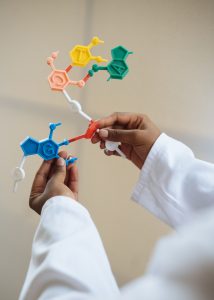 A technique that is used for the joining of two molecules, given that at least one is a biomolecule like a protein, nucleic acid, or carbohydrate, is called bioconjugation. Like most bioprocessing applications, this is quite useful. Among the biomolecules, there is a special diversity in proteins, given how important they are for bioconjugation reactions due to their amino acids. In order for proteins to be modified, bioconjugation reactions must be present. It’s possible for proteins to be altered to have functions like target drug delivery, cellular tracking, and imaging biomarkers, all thanks to the groundbreaking work that has been done in biomolecular studies.
A technique that is used for the joining of two molecules, given that at least one is a biomolecule like a protein, nucleic acid, or carbohydrate, is called bioconjugation. Like most bioprocessing applications, this is quite useful. Among the biomolecules, there is a special diversity in proteins, given how important they are for bioconjugation reactions due to their amino acids. In order for proteins to be modified, bioconjugation reactions must be present. It’s possible for proteins to be altered to have functions like target drug delivery, cellular tracking, and imaging biomarkers, all thanks to the groundbreaking work that has been done in biomolecular studies.
Strategies for Synthesis
Conjugation as a principle of chemistry is simple by itself, but actually trying to perform is exceptionally more difficult. It can be hard to produce bioconjugation reactions due to several obstacles that may arise. Some reactions will be inefficient due to the fact that they can’t be selective because they have a higher prevalence of some amino acid residues. Reactions can also be hindered by the presence of polar molecules on protein surfaces. When multiple parts of a particular protein are being selectively modified, more difficulties can arise.
The usual method of modifying proteins involves targeting side chains of lysine, cysteine, and other amino acids through second order reactions. Amino groups are found in lysine and thiol is found in cysteine, which gives them the ability to react to reagents and become modified. Bioconjugation reactions have become even more efficient than before due to biochemistry advancements and new technologies being developed.
The particular protein that is being targeted will determine which strategy is used. An alternative approach will have to be used if a protein can’t be isolated from the mixture where it resides. The need for site specificity will have to be considered if the purified form of the protein has been found.
Bioorthogonal Reactions
Reactions that can be carried out in living systems without interrupting the native processes at work are called bioorthogonal reactions, which are a bioconjugation reaction subset that more researchers are beginning to notice. Select protein sites can be modified with the use of these reactions. Photochemical switching behaviours, enhanced fluorescence, and surface labelling on live cells are just a few of the applications where they are used.
Two common types of bioorthogonal reactions come in the form of aldehye and ketone modification reactions. Normally these groups aren’t found don the surface of a cell, so once they are attached, they are easy to identify. Hydrazide or aminooxy compounds are coupled with the aldehyde or keytone groups to create linkages between the protein and biomolecule made of bydrazone or oxime.
Modification Through N- and C- Termini
Single residues can be hard to target because proteins may have residues of natural amino acids. Specific residues on C- and N- termini are targeted through certain techniques that increase site selectivity.
N-terminal aldehyde is created in one modification by oxidising threonine or serine residues. This causes the occurrence of bioorthogonal reactions .
NCL or native chemical ligation is a well known form of C-terminal modification. In this modification, thiol groups on N-terminal cysteine residue are combined with thioester residues on the C-terminal of a completely different protein. Smaller polypeptides are combined to create a larger one with this technique. The thioester and thiol interaction, which happens first, is a powerful step that can be reversed, although the formation of amide, which happens next, can’t be reversed. The final product of ligation is quite high in yield because of this.
Labelling-Site Selectivity
Protein sites are selectively modified using the alkylation of cysteine residues. The amount of cysteine residues that are present will affect how well the technique actually is on proteins that are naturally expressed. Vinyl sulfones and iodoacetamides, which are reagents used for the process, can lower selectivity by modifying the other amino acids that are found in the protein.
Purification
More reagents are added when bioconjugation occurs because the reactions don’t reach their full completion. Getting out the final product from the mixture can be an even tougher experience because of this. There aren’t a lot of purification techniques that are present for the reactions. Size-exclusion chromatography is a technique that is easy to do and is commonly used to get particular molecules when the product is large enough that the other present molecules won’t hinder the process. Specific bioconjugation reactions will need to have specific purification techniques made for them if the molecules can’t be extracted this way.